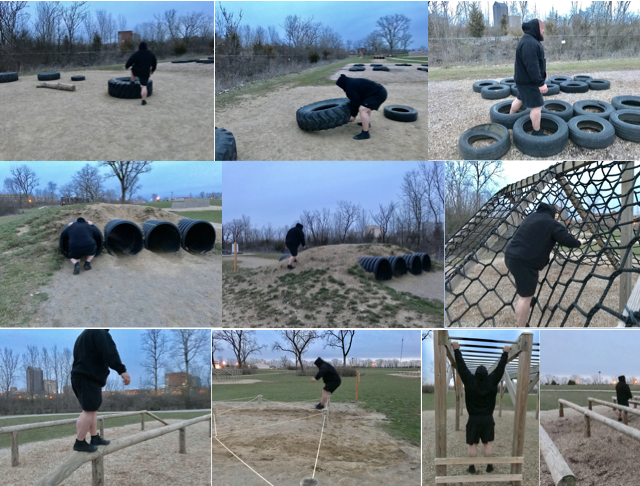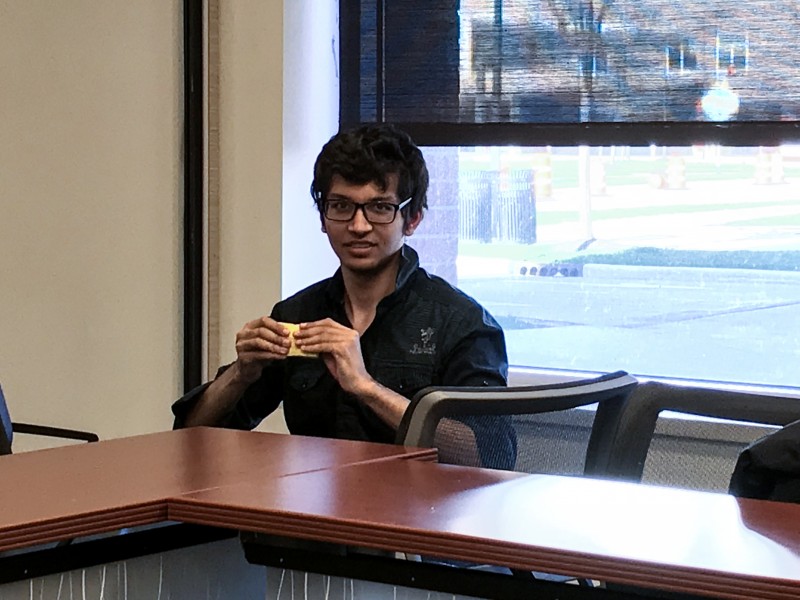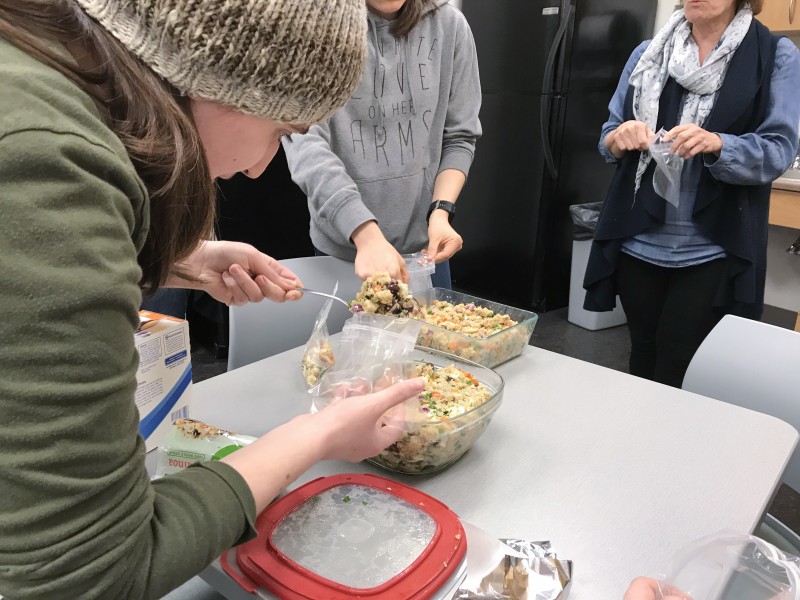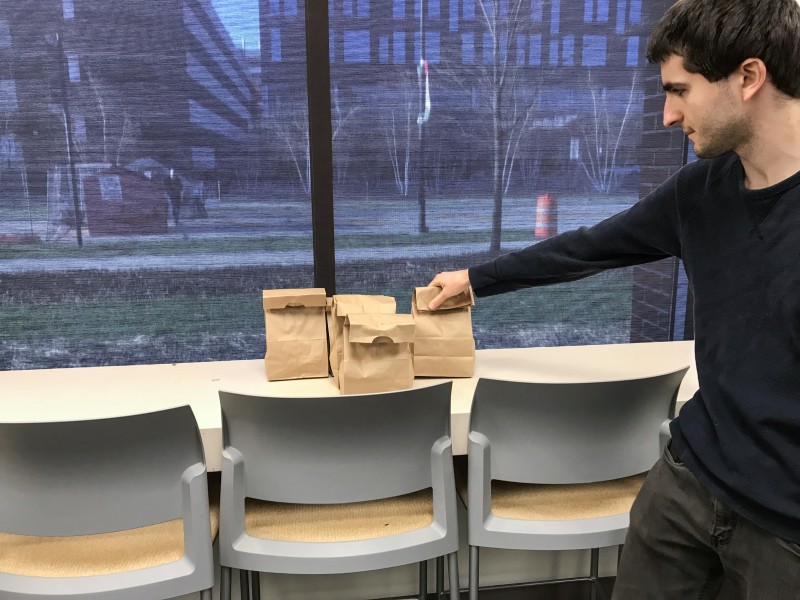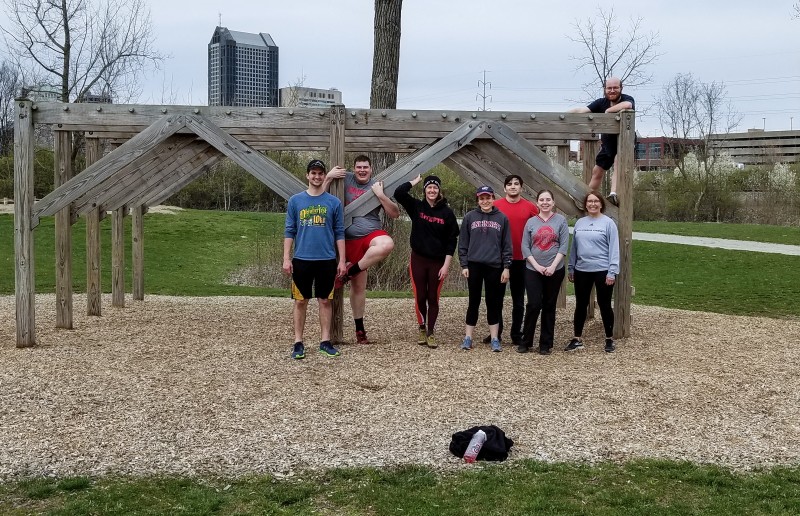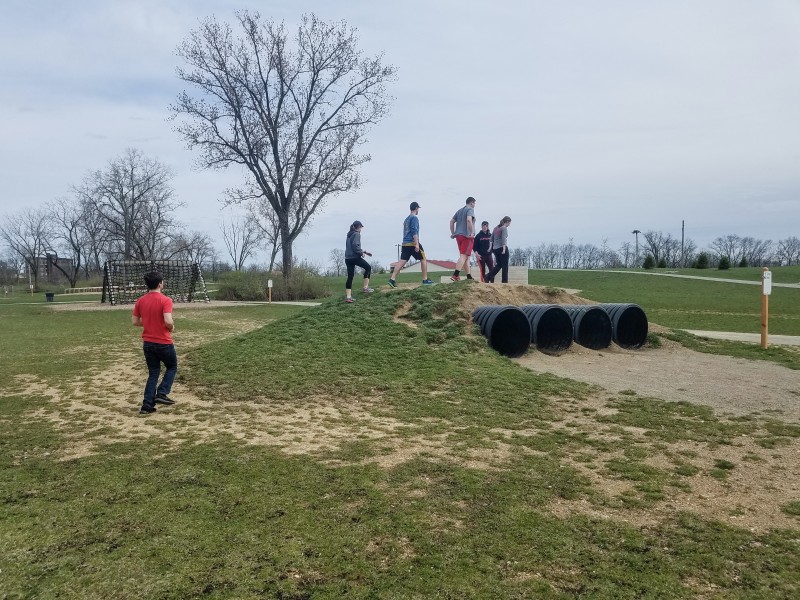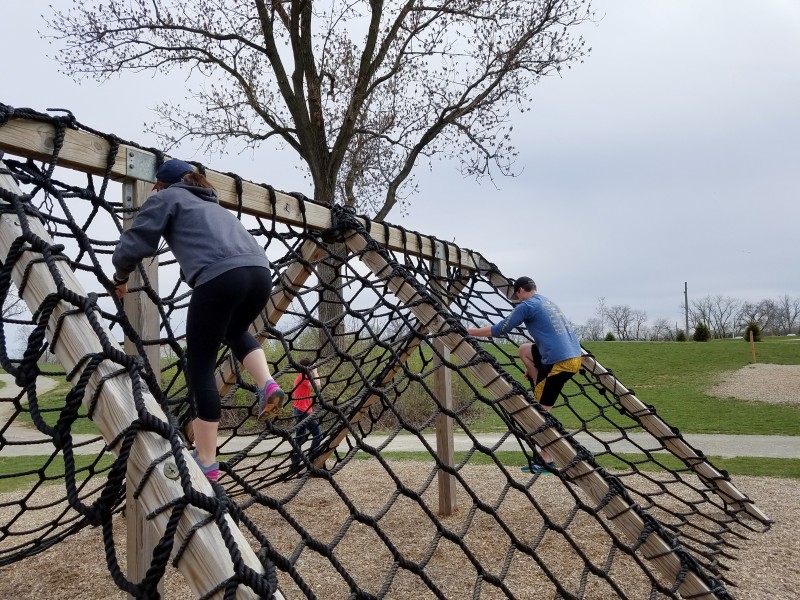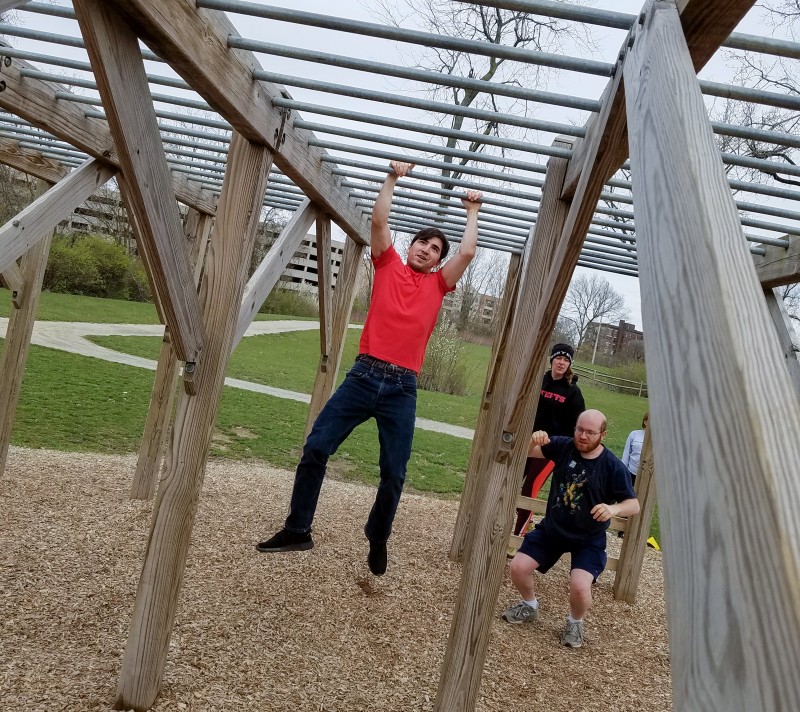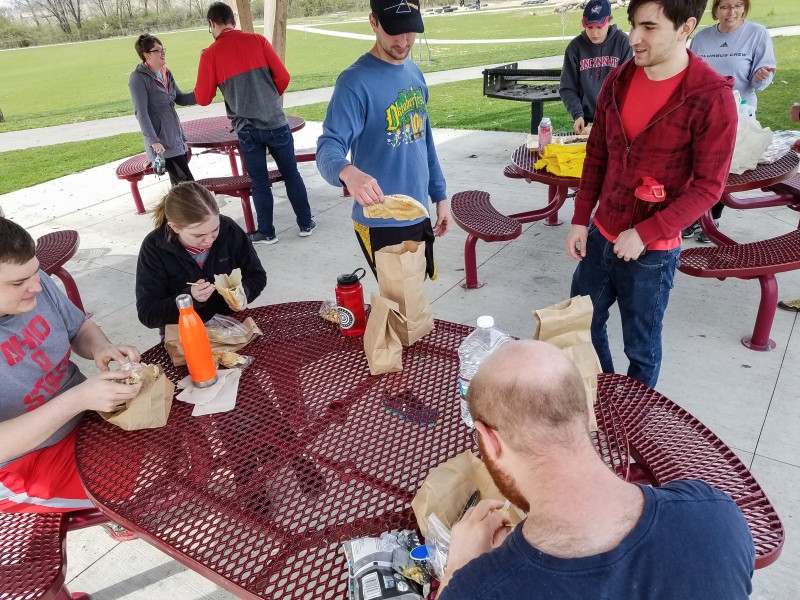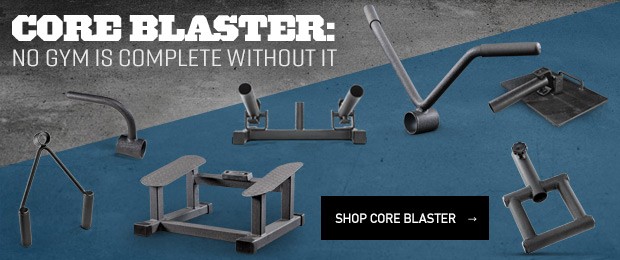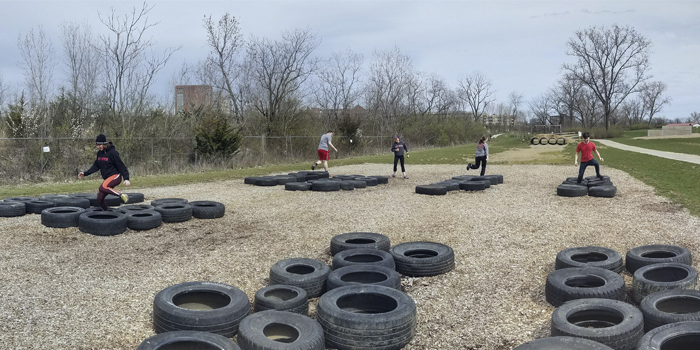
ACE! is a program led by students (and supervised by Nisonger Center directors) for OSU students with high-functioning autism. Each student’s educational track is monitored throughout the school year. In addition to academic support, the group meets weekly to learn and discuss topics of interest related to nutrition, movement, personal care, finances, and community involvement.
As a continuation of the previous lesson for ACE!, Skip the Gym — Create Training Space Indoors and Outdoors, this lesson expanded upon creating training space outdoors. Based on the group’s consensus experiencing the typical college gym setting as something they didn’t want to feel again, this lesson took us to the Scioto Audubon Park to exercise in an outdoors space predetermined with permanent equipment stations settled in a 120-acre park. As a before-finals celebration, over the course of two days we previewed the Scioto Challenge, learned about post-workout nutrition using a crusty sponge, and prepped a post-workout meal. On day two, we exercised at the Scioto Audubon Park and ate our post-workout Greek-infused meal in picnic fashion.
RELATED: Meal Prep Basics for the College Student
Bridging the gap between immobility and action, this lesson served as another opportunity to reshape the student’s negative associations with exercise and revamp their workout creativity in OSU’s backyard. Here’s the prep behind the scenes, the lesson plan’s objectives, and student outcomes. My hope is that you get a chance to recreate some aspect of this lesson plan to reshape any negativity associated with exercise for the children and young adults you work with who sit somewhere on the winding autism spectrum.
Behind the Scenes
For this program, my prep always begins with Karen Edison, ACE’s program coordinator. We met two years ago when I was volunteering evenings at Aspirations and she was early into her master’s degree working as an intern for Aspirations. Since then, our work has continued to overlap. For ACE, she contacts me with ideas and possible lesson dates. We discuss ideas for a few weeks via email, we talk over the phone to pinpoint details that are hard to relay via text, and a week before the lesson date I send her a lesson plan to review. By the time of lesson, I show up and all the supplies requested through the lesson plan are there for my and the students' disposal.
Prior to the lesson plan submission, it was necessary to scope out the training environment at Scioto Audubon Park — for all I knew the landscape could have changed since I was there last summer. Seconds within walking the grounds, the training schedule (our starting point, end point, exercise modifications, team dynamics, etc.,) was easily mapped. This was also a great opportunity to take pictures of each exercise station in action (thank you, JP, for your modeling expertise) to familiarize the students in handout form of the location and physical demands one day prior to the challenge — something Karen and I are striving to prioritize for all future lessons.
Day One — From the Conference Room to the Kitchen
For day one, the objectives of the lesson were for the students to be able to verbalize why post-workout nutrition is a necessity, prep a post-workout meal appropriately for travel, and preview the next day’s Scioto Challenge workout schedule. Although food prep is by no means a new concept for this group of students (based on previous lessons of mine), preparing food to eat after an off-site workout is an entirely new concept. To get started, a used, worn-out, hardened sponge was passed around the room from student to student. Although the students were unsure why a sponge became a focal point, one by one they felt the rigidity of the sponge, twisted the sponge to see how easily it could be torn, and banged it on top of the table to hear its hardness. We talked about how an effective sponge (for cleaning) is one that is mobile, full of water and soap. Flipping the script, we then talked about how muscles, like sponges, become stiff, sore, dehydrated, depleted, and flat if not replenished through food and water after training. After adding water and soap to the sponge (thanks Grace), the students saw and felt the sponge instantly transform into a like-new sponge ready for cleaning. The sponge now waterlogged and supple, we broke down post-workout nutrition — its timing and what constitutes an appropriate post-workout meal comprised of healthy carbohydrate, protein, and fat choices.
And yes, maybe this analogy is a stretch, but if the students can visualize a hardened and easily torn sponge as their muscles if worked and not replenished with water and nutrients, and this motivates them to eat after training (thinking about replenishing muscles for function and form), I’m okay with it. From theory to practice, we walked from the conference room to the kitchen and prepared a post-workout meal appropriate for travel. In assembly-line fashion, each student spooned a serving of Mediterranean Quinoa Salad (recipe below) into a sandwich bag and placed it into a lunch-size paper bag with a hummus pack, baggy of pita chips, a bottle of water, plastic ware, and napkins.
Overall, this meal was intended to show that dinner leftovers combined with a few plastic and paper tools could make post-workout meal prep for the next day very quick and easy. As our last to-do, we previewed the Scioto’s Challenge Schedule to get familiar with the next day’s workout. In an environmental context, this handout gave them a clear starting point, a list of exercises, a set and rep count, and an ending point.
Day Two — From the Park to a Picnic
For day two, the objectives of the lesson were for the students to be able to exercise through eight stations at the Scioto Audubon Park and consume a prepared post-workout meal. On a beautiful spring afternoon (Ohio, you’re too kind), we warmed up by walking from the Scioto Audubon Park parking lot to the first of eight stations — The Tire Pit. For two rounds we climbed the tires situated in a circle (Tire Step-up Around the World) and this deemed challenging (ask Brock) as no two tires were the same, ranging from large to small and firm to flimsy. For ten reps, each student then picked a tire and flipped it for 10 reps. Bracing was an entirely new term for everyone involved, especially during the Tire Flips, so it was a cue continuously used throughout the day. Next up was the Tire Run for six rounds. Again, the tires are of different widths and shapes on an uneven surface, making running very challenging. We had walkers, runners, knees high, and everything in between.
Because the tunnels were full of water and mud, we skipped the Tunnel Crawl and moved to the Tunnel Mound Climb for six rounds. Although the Tunnel Mound Climb is something I made up, I wanted them to see that we can make up our own rules and maintain flexibility per conditions: weather, energy levels, time constraints, etc. It was all about footing here since half of the mound was grass-covered and the other half was pebble and dirt covered. The Rope Climb was next, and although I marked it down for one climb, the students loved its mixture of thrill and accomplishment and wanted to keep climbing beyond one round. So, we climbed and climbed (impressive job, Jamie)!
Six or so climbs later, we moved to the Balance Beam. The wood of the Balance Beam is soft and slippery, especially on the angled piece leading to the beam. We relied on a buddy system for stability to get from one end to the other. Next, we moved on to the Rope Jump. This is intended to be a Rope Crawl in sand, but I modified it to the Rope Jump to get us jumping and keep our clothes (and faces) sand-free. We jumped here and then created races to see who could run from one end to the other the fastest (good idea, Harry).
With sand in our shoes, we walked over to the Monkey Bars. Upper body strength is a clear weakness. To modify this station, we did 10-second hangs. Augustine, on the other hand, climbed from one end to the other multiple times and completed pull-ups. Last but not least, we ended with the Log Shuffle. This station is intended to move under and over the logs, but since we had climbed previously and excessively using the tires and ropes, I wanted the group to move laterally. So we moved laterally between the logs with shuffles and karaokes. After the Log Shuffle, we cooled down by walking uphill to the pavilion to enjoy our well-deserved prepared post-workout picnic.
A Raise of Hands
From crusty to squishy, from the conference room to the kitchen to Scioto Park, over the course of two days the students were able to verbalize at least three reasons why post-workout nutrition is invaluable, they were able to create a post-workout meal and prep it appropriately for travel, they were able to exercise through eight stations (nine exercises) at the Scioto Audubon Challenge, and they were able to eat a timely post-workout meal. As you can see, this lesson had many snapshots along the way, but the big picture of the two-day plan was for the students to gain a replicable alternative to gym training, allowing them to replace negative emotions toward exercise with positive emotions, and get moving. We did just that with a plan and the help of friends and healthy food. When the students were asked to raise their hands if they’d return to the Scioto Park in the future (on their own) to exercise, everyone raised a hand high.
Thank you Karen, Nathan, Jordan, Grace, AshVinny, Megan, Drew, Brock, Augustine, Jamie, Harry, and JP for your participation!
Mediterranean Quinoa Salad
Ingredients
- 2 cups chicken broth
- 1 garlic clove, smashed
- 1 cup Simple Truth Organic Quinoa, uncooked
- 2 large cooked chicken breasts, cubed
- 1 small red onion, chopped
- 1 large orange bell pepper, chopped
- 1/2 cup Kalamata olives, chopped
- 1/2 cup feta cheese, crumbled
- 1/4 cup parsley, chopped
- 1/2 cup chives, chopped
- Salt and black pepper to taste
- 2/3 cup lemon juice
- 1 tablespoon balsamic vinegar
- 1/4 tablespoon olive oil
Directions
In a medium-size saucepan, bring the chicken broth and garlic clove to a boil. Stir in the quinoa, reduce heat to medium-low, cover, and simmer until the quinoa is tender and the chicken broth has been absorbed (15 to 20 minutes). Discard the garlic clove and transfer the quinoa to a large bowl. Gently stir the chicken, onion, bell pepper, olives, feta cheese, parsley, chives, salt, and pepper into the quinoa. Drizzle with lemon juice, balsamic vinegar, and olive oil. Stir until well combined. Serve warm or refrigerate and serve cold. Makes about eight servings.









